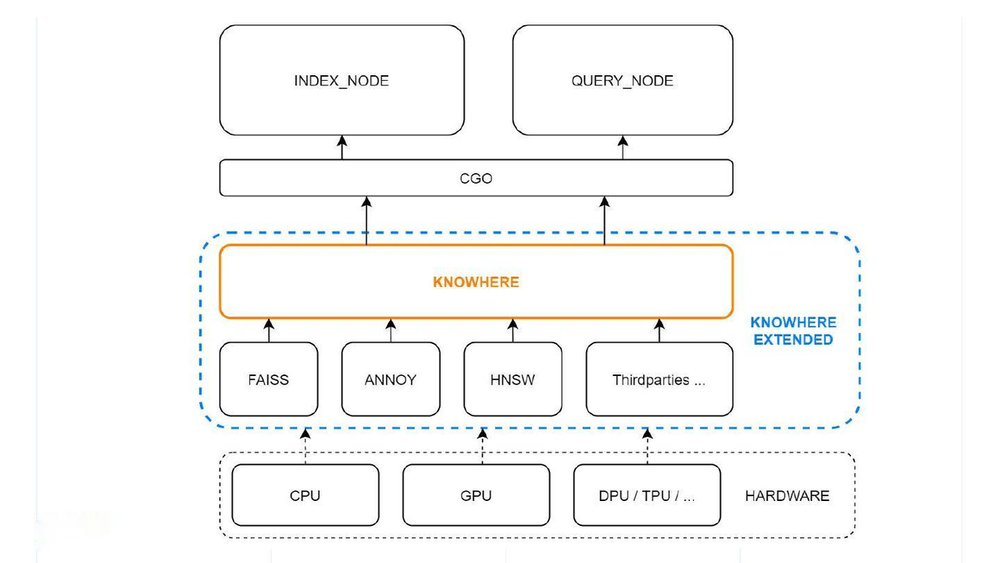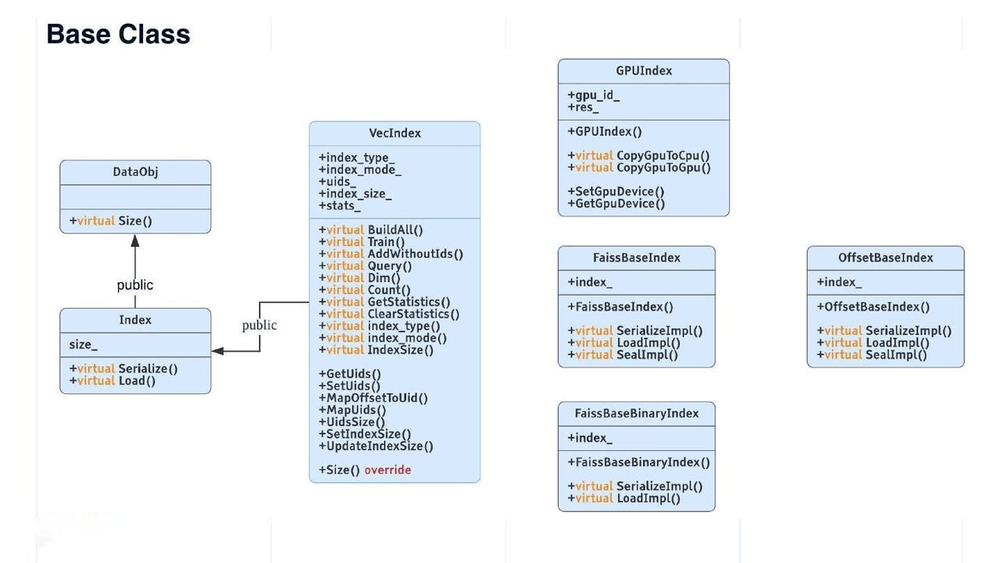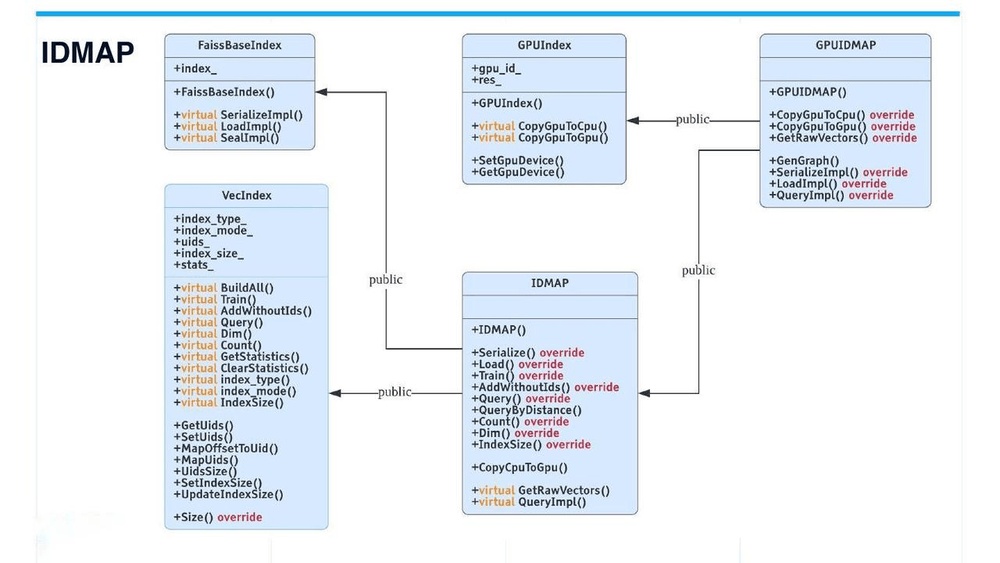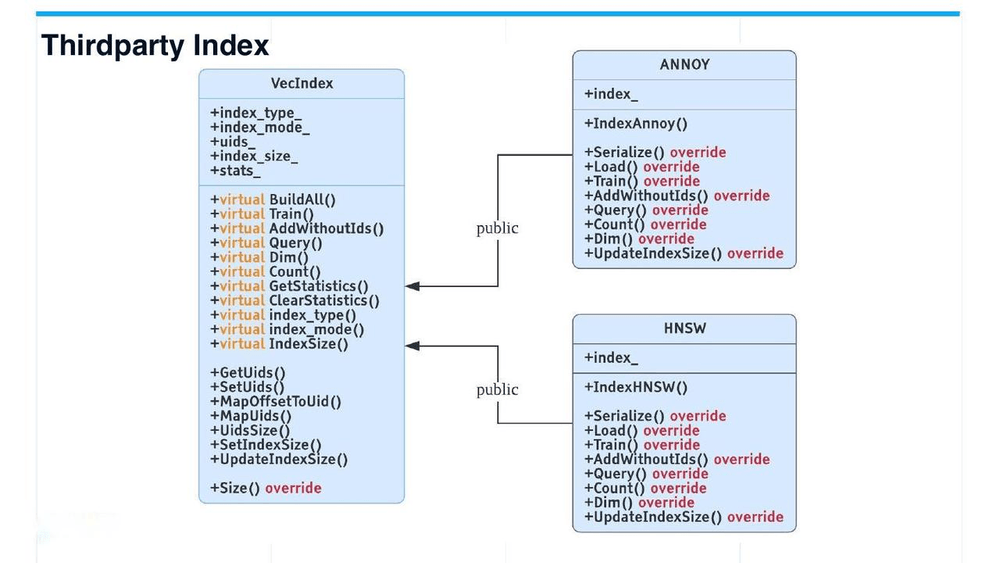Knowhere
本主题介绍Milvus的核心向量执行引擎Knowhere。
概述
Knowhere 是 Milvus 的核心向量执行引擎,集成了多个向量相似度搜索库,包括 Faiss (opens in a new tab)、Hnswlib (opens in a new tab) 和 Annoy (opens in a new tab)。Knowhere 还支持异构计算。它控制在哪些硬件(CPU 或 GPU)上执行索引构建和搜索请求。这就是 Knowhere 的名字的由来 - 知道在哪里执行操作。未来的版本还将支持更多类型的硬件,包括 DPU 和 TPU。
Knowhere 在 Milvus 架构中的作用
下图说明了Knowhere在Milvus架构中的位置。
Knowhere in the Milvus architecture.
最底层是系统硬件,第三方索引库位于硬件之上。然后,Knowhere通过CGO与顶部的索引节点和查询节点交互,这允许Go包调用C代码。
Knowhere优势
以下是Knowhere相对于Faiss的优势。
支持BitsetView
Milvus引入了位图机制实现"软删除"。软删除的向量仍然存在于数据库中,但在向量相似度搜索或查询过程中不会被计算。
位图中的每个位对应于一个索引向量。如果位图中的向量被标记为"1",则表示该向量已被软删除,在向量搜索中不会涉及该向量。bitset参数适用于所有在Knowhere中公开的Faiss索引查询API,包括CPU和GPU索引。
有关位图机制的更多信息,请查看位图。
Support for multiple similarity metrics for indexing binary vectors
Knowhere supports Hamming, Jaccard, Tanimoto, Superstructure, and Substructure. Jaccard and Tanimoto can be used to measure the similarity between two sample sets while Superstructure and Substructure can be used to measure the similarity of chemical structures.
Support for AVX512 instruction set
除了AArch64 (opens in a new tab)、SSE4.2 (opens in a new tab)和AVX2 (opens in a new tab)之外,Faiss 已经支持的指令集,Knowhere 还支持AVX512 (opens in a new tab),可以相对于AVX2提高20%至30%的索引构建和查询性能。
自动SIMD指令选择
Knowhere支持在任何CPU处理器(包括本地和云平台)上自动调用适当的SIMD指令(例如SIMD SSE,AVX,AVX2和AVX512),因此用户在编译时无需手动指定SIMD标志(例如“-msse4”)。
Knowhere是通过重构Faiss的代码库而构建的。依赖于 SIMD 加速的常见函数(例如,相似性计算)被分解出来。然后,针对每个函数,实现了四个版本(即 SSE、AVX、AVX2、AVX512),每个版本都放在一个单独的源文件中。然后,使用相应的 SIMD 标志单独编译源文件。因此,在运行时,Knowhere 可以基于当前的 CPU 标志自动选择最适合的 SIMD 指令,然后使用 hooking 链接正确的函数指针。
其他性能优化
Read Milvus: A Purpose-Built Vector Data Management System (opens in a new tab) for more about Knowhere's performance optimization.
Knowhere code structure
Computation in Milvus mainly involves vector and scalar operations. Knowhere only handles the operations on vector indexing.
索引是一种独立于原始向量数据的数据结构。通常,索引需要四个步骤:创建索引,训练数据,插入数据和构建索引。在一些人工智能应用中,数据集训练与向量搜索分开。来自数据集的数据首先进行训练,然后插入到像Milvus这样的向量数据库中进行相似度搜索。例如,开放数据集sift1M和sift1B区分了用于训练和测试的数据。
然而,在Knowhere中,用于训练和搜索的数据是相同的。Knowhere在一个段 (opens in a new tab)中训练所有的数据,然后将所有训练数据插入并为它们构建索引。
DataObj:基类
DataObj is the base class of all data structures in Knowhere. Size() is the only virtual method in DataObj. The Index class inherits from DataObj with a field named "size_". The Index class also has two virtual methods - Serialize() and Load(). The VecIndex class derived from Index is the virtual base class for all vector indexes. VecIndex provides methods including Train(), Query(), GetStatistics(), and ClearStatistics().
Knowhere base classes.
Some other index types are listed on the right in the figure above.
- The Faiss index has two base classes:
FaissBaseIndexfor all indexes on float point vectors, andFaissBaseBinaryIndexfor all indexes on binary vectors. GPUIndexis the base class for all Faiss GPU indexes.OffsetBaseIndex是所有自研索引的基类。由于索引文件中仅存储向量ID,因此128维向量的文件大小可以降低2个数量级。
IDMAP:暴力搜索
IDMAP code structure.
从技术上讲,IDMAP不是一个索引,而是用于暴力搜索。当向数据库中插入向量时,不需要进行数据训练或索引构建。搜索将直接在插入的向量数据上进行。
然而,为了代码的一致性,IDMAP也从VecIndex类继承了所有虚拟接口。使用IDMAP与其他索引相同。
IVF索引
Code structure of IVF indexes.
倒排索引(IVF)是最常用的索引。 IVF 类派生自 VecIndex 和 FaissBaseIndex,并进一步扩展为 IVFSQ 和 IVFPQ。 GPUIVF 派生自 GPUIndex 和 IVF。然后,GPUIVF 进一步扩展为 GPUIVFSQ 和 GPUIVFPQ。
IVFSQHybrid 是一种自主开发的混合索引。粗糙的量化器在 GPU 上执行,而在 CPU 上执行桶中的搜索。这种类型的索引可以利用 GPU 的计算能力,减少 CPU 和 GPU 之间的内存复制发生。 IVFSQHybrid 具有与 GPUIVFSQ 相同的召回率,但性能更佳。
二进制索引的基类结构相对较简单。 BinaryIDMAP 和 BinaryIVF 派生自 FaissBaseBinaryIndex 和 VecIndex。
第三方索引
Code structure of other third-party indexes.
目前,除了Faiss以外,仅支持两种类型的第三方索引:基于树的索引Annoy和基于图的索引HNSW。这两种常见且经常使用的第三方索引都源于VecIndex。
向Knowhere添加索引
If you want to add new indexes to Knowhere, first you can refer to existing indexes:
- To add quantization-based indexes, refer to
IVF_FLAT. - To add graph-based indexes, refer to
HNSW. - To add tree-based indexes, refer to
Annoy.
After referring to the existing index, you can follow the steps below to add a new index to Knowhere.
- Add the name of the new index in
IndexEnum. The data type is string. - Add data validation check on the new index in the file
ConfAdapter.cpp. The validation check is mainly to validate the parameters for data training and query.
-
为新索引创建一个新文件。新索引的基类应该包括
VecIndex,以及VecIndex的必要虚接口。 -
在
VecIndexFactory::CreateVecIndex()中添加新索引的构建逻辑。 -
在
unittest目录下添加单元测试。
接下来做什么
After learning how Knowhere works in Milvus, you might also want to:
- Learn about the various types of indexes Milvus supports.
- Learn about the bitset mechanism.
- Understand how data are processed in Milvus.



